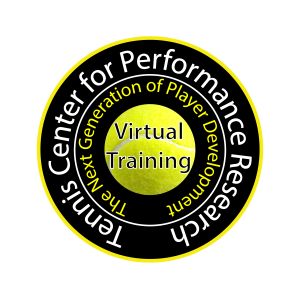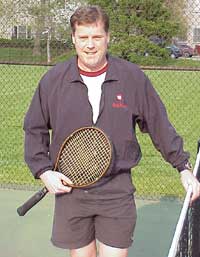The Most Complex Motion
in Sport?
Brian Gordon, PhD
I have stated in many venues that the upward swing of the “power” tennis serve is the most technically complicated movement in all of sport. The upward swing is defined in my work as beginning at the instant the tip of the racquet attains its lowest point vertically coming out of the backswing, ending at contact.
I presume some would debate that it is the "most" complex. Indeed, I concede that certain sports possess complicated (and often dangerous) feats of strength, balance and motion. Yet having researched the serve for many years--actually decades--I've noted several attributes of the “power” serve upward swing that support my position.
The Evidence
For a high-level server the racquet head speed can be increased by 70 mph in 1/10 of a second during the upward swing. (To see an analysis of this on the Sampras serve, Click Here.)
To accomplish this that server will utilize at least nine unique body rotations, many in sequence. And at the end of the upward swing these joint rotations must position the racquet into a precise orientation with very little margin for error.

It would be hard to argue, especially for those who have tried to serve well, that these facts are not impressive. For those of us who try to develop this skill in young players these facts are also quite daunting. Try teaching this rotation sequence, occurring in 1/10 of a second, to your average child of 10 years – good luck.
Reverse Engineering
True understanding of the serve requires knowledge of the body motions that produce the racquet speed in the upward swing. This understanding in turn leads to understanding the body actions that occur in earlier parts of the motion to facilitate the upward swing mechanics. This reverse engineered approach, assessing the ends to understand the means, is a historical microcosm of how I developed my research of serve mechanics over three decades.
So...in this serve article let's start at the beginning (the end of the serve) as a first step to understand all aspects of the entire serve motion. The goal is to describe the serve upward swing motions as a precursor to understanding the underlying mechanics, and as a means to evaluate other portions of the serve. This information from my doctoral dissertation forms the foundation of my coaching methodology.

Upward Swing Kinematics
Kinematics is the branch of mechanics that describes motion (displacement, velocity, acceleration) without addressing the cause of these motions. Using advanced 3D motion measurement equipment and techniques it is possible to determine with high precision the angular velocity (rotational speed) of the body segments and therefore joints.
These angular velocities along with the measured distance from a joint to the racquet face make it possible to determine the contribution each joint rotation makes to the speed of the racquet at each analyzed instant. To describe the primary contributors during the upward swing I consider three rough intervals.
Early Upward Swing
Exiting the backswing the racquet sweeps to the outside prior to moving significantly upward. The primary contributors to this racquet motion are torso twist rotation (predominantly hips) and shoulder external rotation. Wrist extension also contributes during this interval. The vertical influence is from shoulder adduction.
Early Upward Swing Contributors
- Torso Twisting Rotation
- Shoulder External Rotation
- Shoulder Adduction
Mid Upward Swing
The main direction of the racquet motion in this interval is vertically upward. Shoulder adduction contributes most early in the interval. As adduction contribution wanes, elbow extension becomes the largest contributor to the speed of the racquet. This contribution continues until the elbow angle approaches 180 degrees (straight). Concurrent with elbow extension, but to a lesser extent, wrist ulnar deviation contributes to the vertical motion of the racquet.
Mid Upward Swing Contributors
- Shoulder Adduction
- Elbow Extension
- Wrist Ulnar Deviation
Near Contact
Prior to contact racquet motion transitions from vertically up to forward. Just before contact (0.007 sec prior to contact is the last instant for which calculations are possible) shoulder internal rotation and wrist flexion are the primary contributors to racquet speed in roughly equal proportion. Together they account for 80% of the racquet head speed. Torso (predominantly upper trunk or shoulders) twist rotation contributes about 20%.
Near Contact Contributors
- Shoulder Internal Rotation
- Wrist Flexion
- Upper Torso Twist Rotation
What It All Means
From a technical perspective this information is critical to understanding the serve and should be basic knowledge for any coach. But from a practical perspective it is not directly useful to instructing a player to hit a high level serve. The intricacy of these body and joint rotations, and the associated timing pattern is well beyond the pedagogical capability of players.
But...understanding the complexity of the upward swing allows us to understand the implication of the other serve motions (backswing plane, leg drive, cartwheel rotation, etc.) to generating the desired result in the upward swing. This understanding, in turn, allows us to design teaching and training protocols focused on more controllable phases of the serve—the wind up and the backswing.
And this is the key to coaching advanced serve mechanics. By targeting and perfecting the more controllable parts of the motion we can then indirectly build the complex upward swing rotations that account directly for 100% of racquet head speed at ball contact.
This fact seems contrary to common belief that the legs and body rotations are the drivers. It is not contrary, it simply highlights that body motions early in the serve are used to facilitate the rotations in the upward swing--they do not create the racquet speed directly. These relationships are important and will be explored in future articles.
Train Virtually with Brian!
Dr. Brian Gordon is among the most influential and innovative stroke mechanics coaches in tennis--a formally trained sport scientist with a PhD in biomechanics and a high performance coach dedicated to the construction of stroke mechanics solutions for all players.





